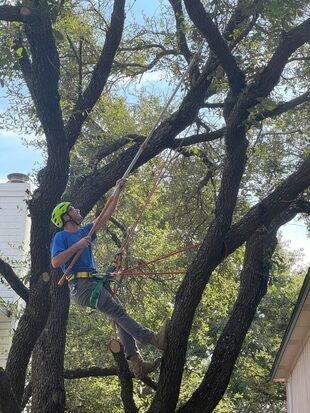 Tree Service can help deal with tree damage after a winter storm Tree Service in Round Rock and Austin TX can help you deal with tree damage after a Winter storm. Winter storms can wreak havoc on trees, leaving behind a trail of destruction that homeowners must contend with. Whether it's heavy snow, ice accumulation, or strong winds, these weather events can cause branches to break, trunks to split, or even entire trees to topple over. Dealing with tree removal after damage from a winter storm requires careful assessment and planning to ensure safety and minimize further harm to property or individuals.
Tree Removal Techniques and Aftercare After assessing the damage and planning the removal process, it's time to take action to safely remove the damaged tree and address any potential hazards or obstacles. Here are some techniques and considerations for dealing with tree removal after damage from a winter storm: 1. Hire a Professional While DIY tree removal may seem like a cost-effective option, it can be dangerous and is not recommended for trees with extensive damage or those located near structures or power lines. Hiring a professional arborist or tree removal service ensures that the job is done safely and efficiently, minimizing the risk of accidents or further property damage. 2. Use Proper Equipment If you do decide to tackle tree removal on your own, make sure you have the proper equipment and protective gear. Chainsaws, ropes, ladders, and safety harnesses are essential tools for safely removing trees. Wear protective clothing, including gloves, goggles, and a hard hat, to protect yourself from falling debris and other hazards. 3. Practice Safe Cutting Techniques When using a chainsaw to cut down a damaged tree, follow safe-cutting techniques to prevent accidents. Make sure the chainsaw is sharp and well-maintained, and always cut at a slight angle to prevent the trunk from splitting and causing kickback. Cut the tree into manageable sections to facilitate removal and disposal. 4. Dispose of Debris Properly Once the tree has been removed, it's important to dispose of the debris properly. Branches, limbs, and other organic materials can be chipped or composted for mulch or other landscaping purposes. Larger pieces of wood can be salvaged for firewood or disposed of at a designated landfill or recycling center. Avoid burning tree debris unless permitted by local regulations and take care to prevent the spread of invasive pests or diseases. 5. Assess and Address Remaining Trees After removing the damaged tree, take the time to assess the health and stability of any remaining trees on your property. Prune any damaged or weakened branches to reduce the risk of future storm damage, and consider consulting with a professional arborist for advice on tree maintenance and care. Investing in preventive measures such as regular pruning, fertilization, and tree inspections can help protect your property from future storm damage and ensure the health and longevity of your trees. Dealing with tree removal after damage from a winter storm can be a challenging and potentially hazardous task, but with careful assessment, planning, and execution, you can safely remove damaged trees and minimize the risk of further damage to your property. Whether you choose to hire a professional tree removal service or tackle the job yourself, prioritizing safety and proper technique is essential for a successful outcome. Work with the most experienced Tree Service in Round Rock and Austin TX Leaf Tree Services is your locally owned professional tree service with certified arborists for residential and commercial customers in Round Rock, Austin, and surrounding Central Texas areas. You can trust your trees to us. Contact us today to schedule a consultation, at 512-670-6766.
0 Comments
Leave a Reply. |
Leaf Tree ServicesLocally owned full service professional tree care serving residential and commercial customers in Austin and surrounding areas for over 20 years. Archives
June 2024
Categories
All
|

 RSS Feed
RSS Feed
